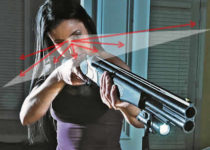Fitting a Shotgun
[su_heading size=”30″]May be a Lost Art[/su_heading]
The once-special fitting process is documented in this great old 1956 video.
Most of us when buying a shotgun these days, would just shoulder one at the gun counter and decide if we like it. This incorrect way of buying a shotgun has cost us many missed shots and the feeling of buyers remorse after the fact.
The correct way (the lost art of custom fitting) is to have a master shotgun fit the shooter with a special adjustable stocked shotgun. With his trained eye this gunsmith would measure what the fit should be. This method provided a quick way to fit and works real well.
With the old skills of the past quickly disappearing we must research past methods on how to correctly buy a shotgun that fits us well.
Another popular method back in the day was to test a gun for size by altering the angle of the stock in relation to the barrel. The gunsmith uses an adjustable gun issued only for fitting customers.
The gunsmith feels that the human eye is more accurate than a machine. In the end custom fitting helps the shooter gain a fuller game bag.
[su_heading size=”30″]Video Transcription[/su_heading]
One sport where you have to be fit is shooting. In both senses of the word. For how many people realize that the sporting gun has to be made to measure to suit individual requirements?
To show you how this is done, we visit an old established gunshop in London’s west end. After the gun has been sighted to determine his master eye –one is usually stronger than the other, and takes control– the angle of the stock in relation to the barrel can be adjusted accordingly. This adjustable gun is used only for fitting customers, for obviously each one varies in height with the shoulder and length of arm. From this can be measured important factors, like the length from jigger to the end of the stock, and the cast-off, or angle the stock is placed in relation to the barrel.
A lot of trouble is taken with attention to detail in the early stages, for an imperfect fit can spoil the value of a pair of guns that cost approximately one-thousand pounds. Yet even a thousand pounds doesn’t seem so much, when one considers the great tradition of craftsmanship that goes into the manufacture of every gun, each one taking nine months to make.
The stock has been made by the skilled hands of Arthur Guinn, from French walnuts, which has been selected for strength of grain, and beauty of figure. By Arthur’s standards, it takes ten days to carve a stock from a solid block, including the fitting of the mechanism, which is made first.
The highly specialized work of checkering the stock is the job of Ebineezer Hans, who’s been a stocker for sixty-eight years. Today, at eighty-four years of age, his hands are as nimbly efficient as ever.
This type of gun is made by hand, because the firm feels that the human eye is more accurate than a machine. In fact, they’ve been made this way for a hundred and thirty-five years. This process, by the way, is the fitting of extractors and mechanism, by Redge Taylor. The gun barrels are made from Nickle steel, and have to pass a pressure test. For the technically-minded, a cartridge when fired sets off a pressure of seven-thousand pounds per square inch, in comparison to a locomotive, which has a pressure of two-hundred and fifty pounds per square inch, although one of course is instantaneous, and the other continues.
The fourfold checking job of Charlie Gandison entails testing the ejectors, testing the weights of trigger pressure -usually about four pounds per square inch- testing the distance between the two triggers using a spacing blank, and finally, testing for balance.
Although they should receive yearly overhauls, sporting guns will last a lifetime if looked after. Symbols of the best in British craftsmanship.
Sources: British Pathé Youtube, Eric Nestor


